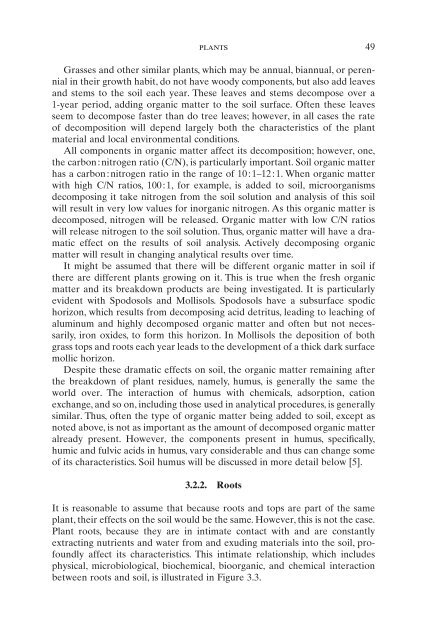Introduction to Soil Chemistry
Introduction to Soil Chemistry
Introduction to Soil Chemistry
You also want an ePaper? Increase the reach of your titles
YUMPU automatically turns print PDFs into web optimized ePapers that Google loves.
plants 49<br />
Grasses and other similar plants, which may be annual, biannual, or perennial<br />
in their growth habit, do not have woody components, but also add leaves<br />
and stems <strong>to</strong> the soil each year. These leaves and stems decompose over a<br />
1-year period, adding organic matter <strong>to</strong> the soil surface. Often these leaves<br />
seem <strong>to</strong> decompose faster than do tree leaves; however, in all cases the rate<br />
of decomposition will depend largely both the characteristics of the plant<br />
material and local environmental conditions.<br />
All components in organic matter affect its decomposition; however, one,<br />
the carbon:nitrogen ratio (C/N), is particularly important. <strong>Soil</strong> organic matter<br />
has a carbon:nitrogen ratio in the range of 10:1–12:1. When organic matter<br />
with high C/N ratios, 100:1, for example, is added <strong>to</strong> soil, microorganisms<br />
decomposing it take nitrogen from the soil solution and analysis of this soil<br />
will result in very low values for inorganic nitrogen. As this organic matter is<br />
decomposed, nitrogen will be released. Organic matter with low C/N ratios<br />
will release nitrogen <strong>to</strong> the soil solution. Thus, organic matter will have a dramatic<br />
effect on the results of soil analysis. Actively decomposing organic<br />
matter will result in changing analytical results over time.<br />
It might be assumed that there will be different organic matter in soil if<br />
there are different plants growing on it. This is true when the fresh organic<br />
matter and its breakdown products are being investigated. It is particularly<br />
evident with Spodosols and Mollisols. Spodosols have a subsurface spodic<br />
horizon, which results from decomposing acid detritus, leading <strong>to</strong> leaching of<br />
aluminum and highly decomposed organic matter and often but not necessarily,<br />
iron oxides, <strong>to</strong> form this horizon. In Mollisols the deposition of both<br />
grass <strong>to</strong>ps and roots each year leads <strong>to</strong> the development of a thick dark surface<br />
mollic horizon.<br />
Despite these dramatic effects on soil, the organic matter remaining after<br />
the breakdown of plant residues, namely, humus, is generally the same the<br />
world over. The interaction of humus with chemicals, adsorption, cation<br />
exchange, and so on, including those used in analytical procedures, is generally<br />
similar. Thus, often the type of organic matter being added <strong>to</strong> soil, except as<br />
noted above, is not as important as the amount of decomposed organic matter<br />
already present. However, the components present in humus, specifically,<br />
humic and fulvic acids in humus, vary considerable and thus can change some<br />
of its characteristics. <strong>Soil</strong> humus will be discussed in more detail below [5].<br />
3.2.2. Roots<br />
It is reasonable <strong>to</strong> assume that because roots and <strong>to</strong>ps are part of the same<br />
plant, their effects on the soil would be the same. However, this is not the case.<br />
Plant roots, because they are in intimate contact with and are constantly<br />
extracting nutrients and water from and exuding materials in<strong>to</strong> the soil, profoundly<br />
affect its characteristics. This intimate relationship, which includes<br />
physical, microbiological, biochemical, bioorganic, and chemical interaction<br />
between roots and soil, is illustrated in Figure 3.3.
















